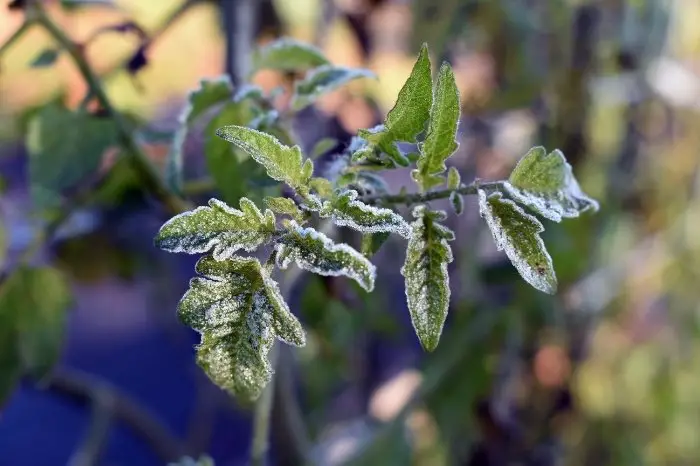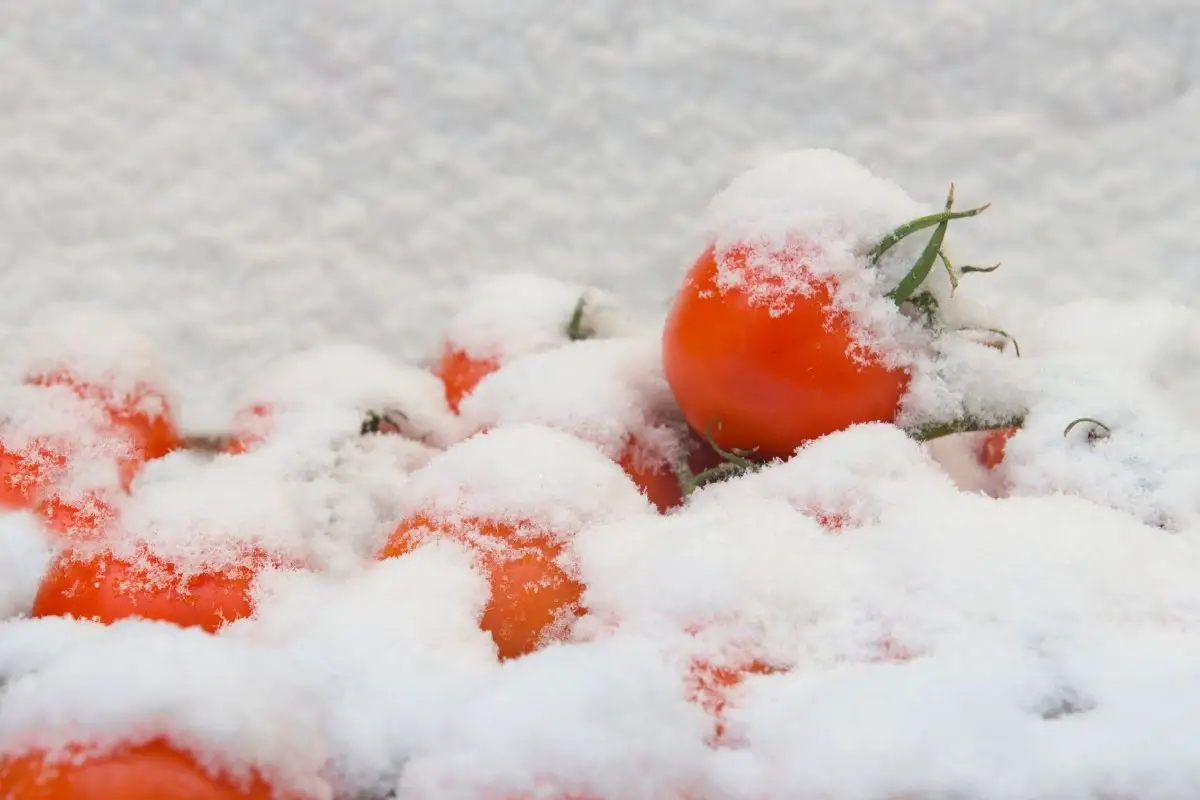Last Updated on October 16, 2022 by Cristina
Cold damage in tomato plants is more common than you could believe. These little fruit trees are extremely sensitive, and a sudden temperature drop could throw them off.
Tomato plants are easy to grow, do great indoors and out, and produce big harvests if you properly maintain them. If you notice your plants have a little cold damage, taking immediate action can save them. In most cases, exposing them to more sunlight can do the trick.
In this article, I explain how tomato plants handle the cold and what the most visible signs of frost damage are. You’ll also read about reviving your damaged plants and what you can do to protect them.
How Much Cold Can Tomato Plants Handle?
Tomato plants can handle some cold, but the duration of their exposure and the temperature they’re exposed to influence how well they manage. The longer your tomatoes are exposed to low temperatures, the worse they’ll damage.
Here’s what different temperatures can do to your tomato plants:
Below 32°F: Brief exposure will severely damage your plants and their fruits, causing them to die.
33°F – 40°F: Extended exposure can cause wilting leaves and stunted growth.
41°F – 50°F: Tomato plants will experience chilling injury with less pollen production in the flowers.
51°F – 55°F: Extended exposure can cause stunted growth, flower drops, and less flavorful fruits.

Take Out Time to Also Read:
What Happens If Tomato Plants Get Frost?
Tomato plants exposed to frost can develop damaged veins. If you notice this on your plants, it’s best to let the leaves fall off and allow your plants to recover naturally. You can also prevent further damage by pruning the wilted leaves.
If your plant stems are damaged below the lowes leaf, it’s unlikely they’ll recover. Your best bet will be to replace your plants.
The Signs Of Cold Damage In Tomato Plants
If you have experienced some particularly chilly days, there’s a chance your tomato plants can suffer from cold damage. Wilting and deformed fruits are the primary signs of this.
New plant leaves that are damaged in the cold will develop olive green or yellowish leaves with a purple hue. Leaves on mature plants can wilt and turn black.
You might also notice deformed fruits. Cold weather early in the season can cause scarred fruits, while fruits growing later in the season will be safe from the cold.
How Do I Revive My Tomatoes From The Cold?
Once the cold hits your tomato plants, it can be challenging to save them. In the worst cases, you can’t. If you notice damage to your tomato plants after cold weather, you can try to revive them using these methods:
Prune Damaged Leaves
Pruning wilted leaves can help your tomato plant recover from cold damage faster. Necessary nutrients will still transfer to dead leaves in an attempt to revive them. In most cases, this fails.
If you remove the damaged leaves from your tomato plant, the unaffected ones will get more nutrients. Your plant will stay healthy and stronger to fight against the next freezing wave that hits it!
5 pack Garden Pruning Shears Stainless Steel Blades, Handheld Scissors Set
Boost Your Tomato Plant With Fertilizers
Adding fast-acting fertilizer to the soil around your damaged tomato plants can help them recover quicker. If they get a nutrient boost, the chances are good that they’ll have the strength to recover from cold damage. You can water your plants when the sun is at its warmest to help the fertilizer kick in faster.
Transplant Your Tomato Plants – Cold Damage In Tomato Plants
Transplanting your tomato plants should be your last resort. However, if you suspect more frost, this is a good option.
Tomato plant roots are very sensitive, and transplanting them can cause more damage. You should be confident that their new soil is nutrient dense and have a sunny spot ready to place them in.
After transplanting them, add fertilizer around the stems and water them regularly to help their roots establish. It might take a few days for your plants to look lively, so be patient.
Can Plants Bounce Back From Frost?
Most plants can bounce back from frost, depending on the severity of their damage.
If your tomato plant stems and fruits are frozen, they can’t recover. Mild frost will only stiffen them, and this is easily reversible with water. You can mist them with lukewarm water from the bottom to the top. Damaged leaves should be pruned.
You can move tomato plants in containers to a frost-free spot that receives more sun.
How To Protect Tomato Plants From Frost
Prevention is better than struggling to cure your tomato plants from cold damage. There are a few ways you can protect from Cold Damage In Tomato Plants. Here are my two favorites:
Cover Your Tomato Plants With Frost Cloth
Frost cloth and other coverings can protect your tomato plants from frost and prevent severe or any damage. You can buy frost cloth from gardening stores or create your own with materials like canvas or pure cotton if you have some lying around. Plastic and bubble wrap will work too.
Remember to remove the frost cloth in the mornings to ensure your tomato plants get enough sunlight.
Move Your Tomato Plants Indoors
If your tomatoes are planted in containers, move them indoors or to frost-free areas at night. This will protect them from the cold and ensure they don’t get damaged. You should place them in a sunny spot during the day.
Final Words – Cold Damage In Tomato Plants
Waking up to droopy and damaged tomato plants can break your heart, especially if you had high hopes for a plentiful harvest. If you don’t take preventative measures, your plants can severely damage in the cold.
Tomato plants are sensitive and need a little extra care when temperatures drop. If you neglect them, you’ll have to tackle any cold damage issues you spot immediately. Doing this can help you save your plants!
I hope you enjoyed this article. If you have more questions about tomatoes, frost damage, or other crops, ask them in the comments.



